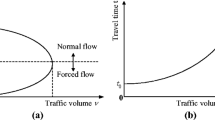Abstract
The focus of this work is to develop a convex mathematical program for static user equilibrium under uncertain link states where users learn the actual state of the arc when they traverse the network and update their route choice in an online manner. The proposed model accounts for one step information where users learn the cost functional form of the links when they reach the upstream node. Two variations of information learning is considered: one where all users reaching a particular node see the same arc states, and another where different users learn different arc states. A convex mathematical programming formulation is proposed and a solution methodology based on the Frank-Wolfe algorithm is provided. Properties of the equilibrium such as existence and uniqueness are discussed. Numerical experiments are conducted on two networks: Nguyen Dupuis and Sioux Falls. Even though the focus of this paper is primarily traffic networks, the fundamental equilibrium model can be applied to other network models where commodities receive information about the state of the network as they traverse the network.


Similar content being viewed by others
References
Andreatta G, Romeo L (1988) Stochastic shortest paths with recourse. Networks 18:193–204
Bar-Gera H (2002) Origin-based algorithm for the traffic assignment problem. Transp Sci 36(4):398–417
Bell MGH, Lida Y (1997) Transportation network analysis. Wiley, New York
Croucher JS (1978) A note on the stochastic shortest route problem. Nav Res Logist Q 25:729–732
Dial R (2006) A path-based user-equilibrium traffic assignment algorithm that obviates path storage and enumeration. Transp Res Part B 40(10):917–936
Ferris MC, Ruszczyński A (2000) Robust path choice in networks with failures. Networks 35:181–194
Friesz TL, Bernstein D, Stough R (1996) Dynamic systems, variational inequalities, and control theoretic models for predicting time-varying urban network flows. Transp Sci 30(1):14–31
Friesz TL, Bernstein D, Mehta NJ, Tobin RL, Ganjalizadeh S (1994) Day-to-day dynamic networtk disequilibria and idealized traveler information systems. Oper Res 42(6):1120–1136
Gao S (2005) Optimal adaptive routing and tra?c assignment in stochastic time-dependent networks. PhD thesis, Massachusetts Institute of Technology
Hamdouch Y, Marcotte P, Nguyen S (2004) A strategic model for dynamic traffic assignment. Networks and Spatial Economics 4:291–315
Marcotte P, Nguyen S (1998) Hyperpath formulations of traffic assignment. Kluwer, Boston, pp 175–199
Marcotte P, Nguyen S, Schoeb A (2004) A strategic model of traffic assignment in static capacitated networks. Oper Res 52:191–212
Miller-Hooks E (2001) Adaptive least-expected time paths in stochastic, time-varying transportation and data networks. Networks 37(1):35–52
Nguyen S, Pallottino S (1989) Hyperpaths and shortest hyperpaths: combinatorial optimization. In: Lecture notes in mathematics, vol 1403. Springer, Berlin, pp 258–271
Opasanon S, Miller-Hooks E (2001) Least expected time hyperpaths in stochastic, time-varying multimodal networks. Transp Res Rec 1771(-1):89–96
Polychronopoulos GH, Tsitsiklis JT (1996) Stochastic shortest path problems with recourse. Networks 27:133–143 (1996)
Ukkusuri SV, Mathew TV, Waller ST (2007) Robust transportation network design under demand uncertainty. Comput-Aided Civil Infrastruct Eng 22(1):6–18
Waller ST, Ziliaskopoulos AK (2002) On the online shortest path problem with limited arc cost dependencies. Networks 40(4):216–227
Ziliaskopoulos AK, Wardell W (2000) An intermodal optimum path algorithm for multimodal networks with dynamic arc travel times and switching delays. Eur J Oper Res 125:486–502
Acknowledgements
The authors would like to thank Patrice Marcotte and Satish Ukkusuri for their comments on the topic during conferences in the past few years which have played an important role in shaping this paper and future work in this area. The research is based on the work supported by the National Science Foundation (NSF) project, Accounting for Information and Recourse in the Robust Design and Optimization of Stochastic Transportation Networks.
Author information
Authors and Affiliations
Corresponding author
Rights and permissions
About this article
Cite this article
Unnikrishnan, A., Waller, S.T. User Equilibrium with Recourse. Netw Spat Econ 9, 575–593 (2009). https://doi.org/10.1007/s11067-009-9114-y
Published:
Issue Date:
DOI: https://doi.org/10.1007/s11067-009-9114-y




